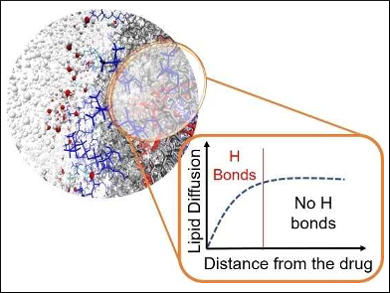Temoporfin is a drug used to treat cancer in photodynamic therapy. It is hydrophobic and, thus, aggregates when it is administered intravenously. This lowers the efficacy of the drug. One way to improve the efficacy is to use liposomal formulations, which avoid aggregation by encapsulating the drug in a vesicle with a hydrophilic outer surface. The success depends on the interactions which are responsible for the vesicle loading capacity and regulate the delivery to the tumor cells.
Leticia González, Juan J. Nogueira, University of Vienna, Austria, and Martina De Vetta, University of Vienna and Universidad Autónoma de Madrid, Spain, have investigated the intermolecular interactions between the photosensitizer Temoporfin and a liposome using molecular dynamics (MD) simulations with a resolution down to single atoms.
The drug participates in a hydrogen-bond network with the phospholipids of the liposome. This reduces the mobility of the lipids and enhances the vesicle’s loading capacity. According to the researchers, the same interactions are also expected to modify the delivery of the drug into the cell membrane of a tumor cell. Further simulations of this process and of the initial interaction between light and Temoporfin, which initiates the cytotoxic mechanism, are in progress.
- Hydrogen Bonding Regulates the Rigidity of Liposome‐Encapsulated Chlorin Photosensitizers,
Martina De Vetta, Leticia González Juan J. Nogueira,
ChemistryOpen 2018.
https://doi.org/10.1002/open.201800050




